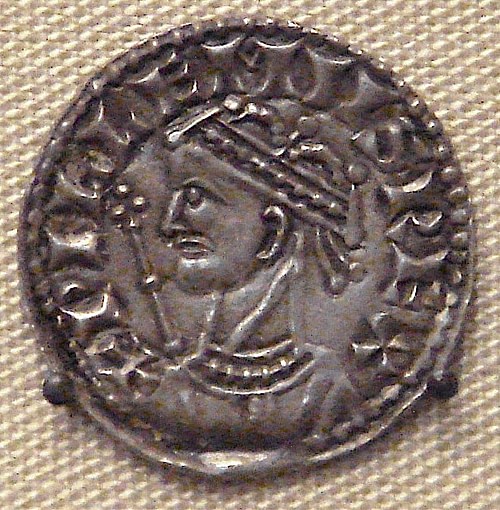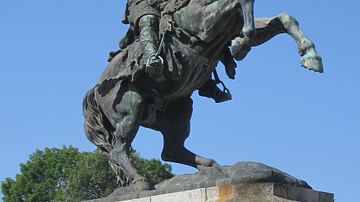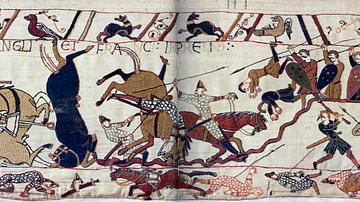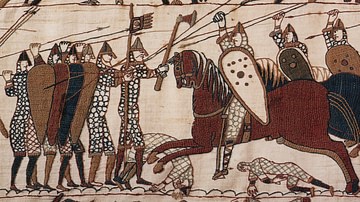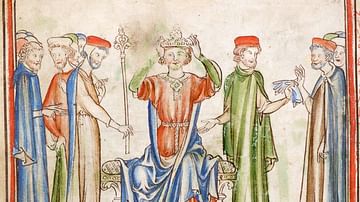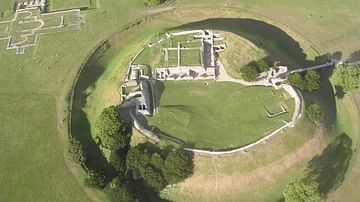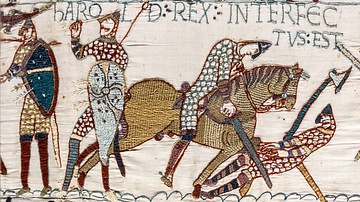William the Conqueror (r. 1066-1087 CE) was victorious at the Battle of Hastings in October 1066 CE, and Harold Godwinson, King Harold II of England (r. Jan - Oct 1066 CE) was dead. The English throne and kingdom were there for the taking but there was still much work to be done before the Normans could claim the rights of conquest. Taking Romney, Dover Castle, Canterbury, and Winchester, amongst others, William's army captured and subdued towns and fortifications throughout the south-east of England until, finally, the Conqueror turned south and marched on London in November 1066 CE. The city, then the focal point of Anglo-Saxon resistance, surrendered without a fight so that William was able to be crowned in Westminster Abbey on Christmas Day of 1066 CE. The conquest of England was by no means complete but it was clear that the Normans were here to stay.
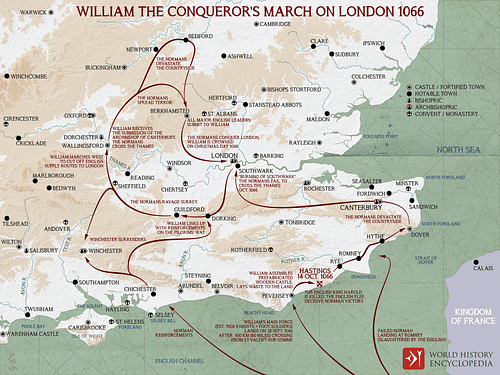
Invasion: Hastings 1066 CE
Williams the Conqueror's invasion of England got off to a spectacularly successful start when his 5-8,000-strong army was victorious over the similarly sized Anglo-Saxon army led by Harold Godwinson, King Harold II of England at the Battle of Hastings on 14 October 1066 CE. However, victory at Hastings, near the south-east coast, did not mean the Norman conquest was all over and dusted in a single battle. Some of the survivors of Harold's defeated army rallied in London, along with those soldiers who had not had time to muster for Hastings. There remained, too, many fortifications, towns and a rival claimant to the English throne for William to deal with, and that was only the south-east corner of a kingdom whose population were likely none too keen to switch allegiance to a foreign ruler.
Dover Castle & Canterbury
First off after Hastings, then, William had to take care of London and the other major towns of the south-east of England. The invading army tended to its dead, looked after the wounded, and prudently rested for a few days, camping near Hastings. It may also be that William was hoping for the remaining Anglo-Saxon leadership to give itself up and pay homage to him as their new leader, although none were forthcoming. The main battle was over but clearly not the war.
On 20 October, the army headed east, marching along the coast and arriving at Romney where a pocket of Anglo-Saxon resistance was defeated and the fortified town torched. The contemporary Norman chronicler, William of Poitiers records that Romney was also picked out for special treatment because it had ruthlessly slain a party of Norman soldiers who had landed there in error when the original invasion fleet had crossed from Normandy. William next marched to the key strategic stronghold of Dover Castle. Although at this early date the castle was merely a fortified settlement or burh, it was, nevertheless, an important point of defence which guarded the south-east coastline and access to the kingdom's interior.
William arrived at Dover on 21 October but, as it turned out, news of the destruction of Romney had reached the burh and the defenders surrendered without resistance; the nearby town was not so fortunate to escape and was plundered and torched. Dover was then refortified and garrisoned to protect William's rear as he marched inland. The wooden Norman motte and bailey castle there would be rebuilt in stone in the 12th century CE, and it remained an important part of coastal defences right into the 20th century CE.
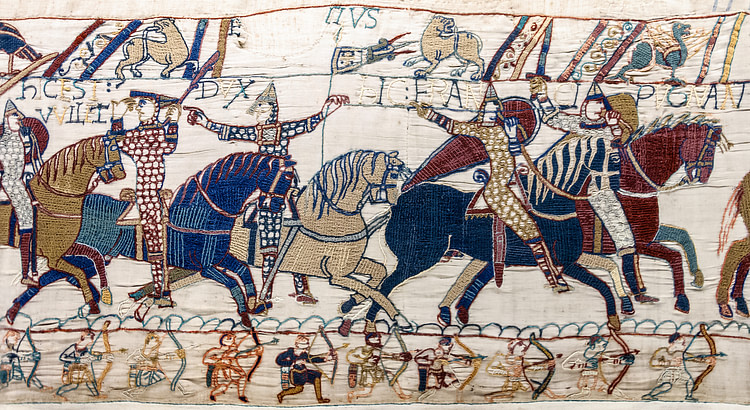
Although he had to delay his campaign as a wave of dysentery hit his army at Dover between 21 and 28 October, next in the Conqueror's sights was Canterbury. The cathedral city was not only important as the see of the archbishop - the highest religious office in England - but was also wealthy and so it provided William with the chance to offer his men some of their long-promised war-booty. The archbishop Stigand was not in Canterbury at the time, but with control of the city, William was finally ready to march on London and stamp out any lingering Anglo-Saxon resistance there.
Wallingford & Winchester
William's army arrived within sight of London in November but was immediately presented with the problem of how to access the city. London was protected by the River Thames, the only access point being a fortified bridge which would have been easily defended by a small force. Deciding not to risk a river crossing, William torched the suburb of Southwark instead, although there may have been a minor skirmish between the two sides. Resistance was being organised within the city by Eadwine, earl of Mercia, and Morcar, the earl of Northumbria. The figurehead around whom this resistance rallied was the teenager Edgar aetheling, great-nephew of Edward the Confessor (r. 1042-1066 CE). At the same time, for safety's sake, the widow of Harold II, Queen Ealdgyth, was sent away to Chester.
William had time on his side and he seemed in no particular rush to take unnecessary military risks with the limited force at his disposal - London could wait. Near the end of October, William had been boosted by the arrival of reinforcements from France. Landing near Portsmouth, they marched northwards, advancing to Winchester, then the seat of the English government, the site of the royal treasury and capital of the important county of Wessex. William marched westwards to meet his second army and Winchester was taken at the end of October, the city submitting without violence on condition of the payment of a hefty tribute. The Norman duke then marched further north and attacked Wallingford, which provided an easy crossing point of the River Thames. There, another castle was built and Stigand was found, the Archbishop formally swearing submission to his new ruler.
The Fall of London
Marching northwards again to the area around Luton, William then turned directly south: the invaders had, in effect, performed a massive loop around southern England, and now London was to be attacked from the north. With the Normans in control of the southern coast and the roads leading to London, the great city was cut off from any possible relief forces. To further isolate London and warn of the consequences of futile resistance, the lands between Bedford and Hertford (located between the great north-south roadways of Ermine and Watling Streets) were severely ravaged, towns burned and citizens murdered. Yet another castle was built at Berkhamsted, too, some 50 kilometres (30 miles) from London, completing the enormous territorial encirclement of London that William had been carefully constructing over the last two months since his victory at Hastings.
The situation in London became even grimmer when, at least according to some contemporary sources, Eadwine and Morcar fled back to their earldoms in the north. Regarded as villainous traitors for their abandonment, the two young earls may have felt compelled to leave before William's encirclement was complete and so provide at least a glimmer of hope for a future Anglo-Saxon fightback. Thus, in the first half of December and facing the prospect of a desperate blockade without the military strength to resist William's army, the English military leaders, bishops, and Edgar all marched to Berkhamsted and presented their collective surrender to William. The Conqueror was lenient with the defeated English nobles, and the city of London was guaranteed all the rights it had enjoyed under Edward the Confessor, including the right of inheritance (a writ dating to 1067 CE recording this still survives today). Three new Norman castles were immediately built in the city, one of which, when stonework replaced the original wooden fort, would become the famous Tower of London. These fortifications and their garrisons ensured that when William finally arrived in person, any lingering unrest would be kept to a minimum.
William's Coronation
The Norman duke was crowned William I, king of England on Christmas Day of 1066 CE at Westminster Abbey, bringing an end to 500 years of Saxon rule. There was a little trouble on the day itself when the Normans guards, posted outside the Abbey by a cautious William, mistook the shouts of acclamation from within as some sort of crowd trouble and started torching the buildings in the immediate vicinity. Perhaps this story was merely a cover for an embarrassingly-timed bit of looting by William's troops. It was a reminder, though, that William might have the crown but not yet the loyalty of the people. The new king still only controlled south-east England but that did not stop him from giving out gifts and booty to his followers and sending English church treasures to the churches of Normandy. As it turned out, the Conqueror would have to struggle for five more years - winning battles against rebels in the north of England and building Norman motte and bailey castles everywhere - before he completely controlled his new realm.
